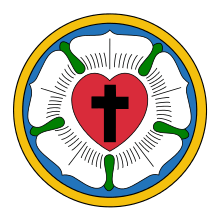Anti-Missourian Brotherhood
| Part of a series on |
| Lutheranism |
|---|
 |
|
|
|
|
Bible translators
|
|
Theologians
|
| Lutheranism portal |
Anti-Missourian Brotherhood was the name of a group of Lutheran pastors and churches in the United States that left the Norwegian Synod. [1]
In 1872, the Norwegian Synod had been a co-founder of the Evangelical Lutheran Synodical Conference of North America, along with the Missouri, Wisconsin, and Ohio Synods. The Norwegian Synod soon experienced internal division over questions concerning predestination and conversion, a conflict known as Predestination Controversy (naadevalgsstriden).
During the decade of the 1880s about a third of its congregations left. The dispute led to hard feelings and a polarized church body. There were depositions of pastors by their congregations, squabbles over ordinations and the editorial policies of periodicals, disputed elections of district officers and the like. The Anti-Missourian Brotherhood began to function as an entity within the Synod and established its own seminary at St. Olaf College in 1886. [2]
The Anti-Missourians were so named because they disagreed with the predestination positionthat was held by the Lutheran Church-Missouri Synod. The Anti-Missourians opposed the views of Dr. C. F. W. Walther, of Concordia Seminary in St. Louis, Missouri, on these questions. They left the Synod at its annual meeting in Stoughton, Wisconsin during 1887. Among the leading advocates of the anti-Missourian position were St. Olaf College founding pastor, Bernt Julius Muus, J. N. Kildahl and Thorbjorn N. Mohn (both St. Olaf College Presidents) together with Luther Seminary Professor M. O. Bockman. [3]
These dissenting "Anti-Missourian Brotherhood" congregations joined in 1890 with the Norwegian Augustana Synod and the Norwegian-Danish Conference to form the United Norwegian Lutheran Church of America which was a forerunner of the Evangelical Lutheran Church in America.
References
- ↑ The Lutherans in North America (Nelson, E. Clifford The Predestination Controversy, pp. 315-ff. Fortress Press, Philadelphia,PA. 1975)
- ↑ The United Norwegian Lutheran Church of America, A Historical Sketch (Ingebrikt Grose. Rolvaag Library. St. Olaf College. Northfield, MN)
- ↑ The Predestination Controversy (The Scheie, Fosmark, Oppegaard, Mykleby Families)